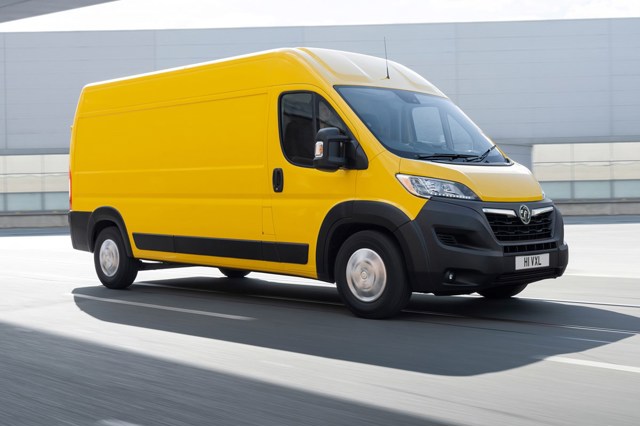Vauxhall Movano Electric (2021 – 2024) Review
Vauxhall Movano Electric (2021 – 2024) At A Glance
Large electric vans are a relatively small segment of the van market thanks to their often-limited payload, which is at odds with their bulky bodywork. But they still have their place if a limited range and payload aren’t an issue. The Vauxhall Movano Electric was a relative latecomer to the plug-in large van market – but how does it measure up? Read our full Vauxhall Movano Electric review to find out.
When Vauxhall severed joint venture ties with Renault-Nissan and became part of the Stellantis Group, its entire van range was replaced by rebadged versions of Peugeot and Citroen models. Among them, the Movano was perhaps the most awkward fit, with the previous generation being much more adaptable and appealing to converters.
The basic van shares its bodywork and engines with the Peugeot Boxer, Citroen Relay and Fiat Ducato, so it stands to reason that its battery and electric motor are also shared on the plug-in model.
The Vauxhall's Movano Electric debuted in 2021 as the Movano-e but was renamed Vauxhall Movano Electric after just six months on sale. At launch, it had a 70kWh battery but from late 2022 that was increased to a 75kWh unit – early models have a range of 139 miles, while later models push that up to 154 miles on the WLTP test cycle.
There are multiple body styles available – three lengths and a choice of cab with a single roof height – and just the one trim level known as ‘Prime’, but it’s well-equipped with electronic climate control, cruise control and a touchscreen as standard. Safety features include forward collision alert, blind spot warning, brake assist and lane departure warning.
Apart from the badging and the charging flap, there are no other clues that it’s an electric version of the Movano which, badges aside, looks identical to the Citroen Relay, Peugeot Boxer and Fiat Ducato.
Driving the Vauxhall Movano Electric (2021 – 2024)
Only one battery option is offered on the Vauxhall Movano Electric – a 75kWh set-up with a WLTP range of 154 miles – an improvement of 15 miles over the earlier 70kWh battery but still some way behind the electric variants of other large vans such as the Ford e-Transit.
With the norm now being to expect a range of around 200 miles, this does limit the Movano Electric’s appeal, especially to private users and SMEs. A van like this will have plenty of appeal, still, to large fleets specialising in last-mile multi-drop work, but for the small business user it’ll only really work in urban environments or for local jobs.
Performance-wise, it goes fairly well though thanks to a 122PS electric motor, which is comparable to the 120PS diesel engine found in the standard Vauxhall Movano, though it lacks the ICE version’s torque when ascending hills.
There are three driving modes - ECO, NORMAL and POWER, with a 'B' option that feeds energy back into the battery. You’ll only achieve full range in Eco mode.
Otherwise, it drives pretty much the same as a standard Movano, which means excellent visibility for such a large van, but with extremely light steering that can feel a little vague at speed. It rides well with a full load but can be a bit crashy over bumps. Manoeuvrability is impressive, with an excellent turning circle for such a large van.
Vauxhall Movano Electric (2021 – 2024) interior
There aren’t as many body permutations with the Vauxhall Movano Electric as there are with the standard panel van, but for a low-volume model that’s hardly surprising.
You can still choose from short, medium and long-wheelbases though, but with the standard ‘H2’ mid-height roof. Even in its smallest layout the load bay is pretty vast but the biggest chink in its armour comes in the form of a very limited payload – just 710kg in the medium wheelbase version and an even more compromised 665kg in the heavier long wheelbase model. Compare that with the Renault Master E-Tech, which can manage up to 1,490kgs, and you can instantly see why Vauxhall’s large van is no longer the heavy duty machine it was when the company was allied with Renault.
As for the load bay, it’s not only huge but also easily accessed with the same capacities as diesel Vauxhall Movanos – so between 13 and 17 cubic metres depending on wheelbase, with a loading height of 1.93 metres.
The cabin is reasonably well-trimmed – a little dated in places as the basic van can trace its roots back to 2006, but nevertheless smart and well-finished with some welcome recent upgrades such as its touchscreen, while functionality is still among the best-in-class.
The passenger seat includes a drop-down desk unit, with up to 10 additional in-cab storage areas including a huge glovebox, document clip and multiple lidded compartments on the dash.







:no_upscale():format(webp)/https://cdn.uk.prod.group-mobility-trader.com/images/cas/671a7bacc220c2e28cde7317ecb5916f/411e1acdda9d5ce6b8dfbb8241984202.jpg)

 Spacious, huge load bay, array of body styles
Spacious, huge load bay, array of body styles
 Bad: Expensive, limited range, dated in areas
Bad: Expensive, limited range, dated in areas
:no_upscale():format(webp)/https://cdn.uk.prod.group-mobility-trader.com/images/cas/848df7c04eb79d4effcff0506709e86c/a70a36053750bfc82082af7e66192e3a.jpg)
:no_upscale():format(webp)/https://cdn.uk.prod.group-mobility-trader.com/images/cas/0eaeae8968cd0480f99e258f126beeb0/f3c55fd23ecf1e1a363d123d3b08c929.jpg)
:no_upscale():format(webp)/https://cdn.uk.prod.group-mobility-trader.com/images/cas/ec7d9850b980149ec6168af736ab7445/feff3324cf1e092421b64073754ac0d8.jpg)